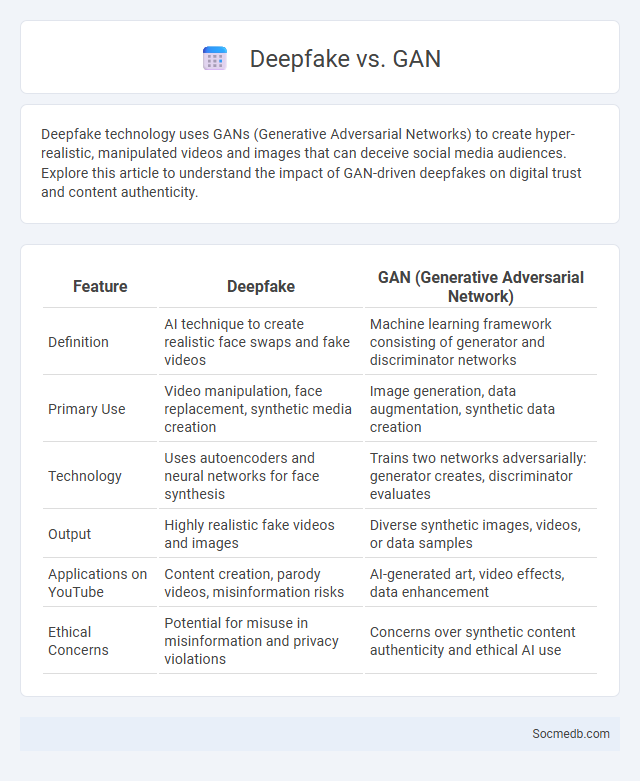
Photo illustration: Deepfake vs GAN
Deepfake technology uses GANs (Generative Adversarial Networks) to create hyper-realistic, manipulated videos and images that can deceive social media audiences. Explore this article to understand the impact of GAN-driven deepfakes on digital trust and content authenticity.
Table of Comparison
| Feature | Deepfake | GAN (Generative Adversarial Network) |
|---|---|---|
| Definition | AI technique to create realistic face swaps and fake videos | Machine learning framework consisting of generator and discriminator networks |
| Primary Use | Video manipulation, face replacement, synthetic media creation | Image generation, data augmentation, synthetic data creation |
| Technology | Uses autoencoders and neural networks for face synthesis | Trains two networks adversarially: generator creates, discriminator evaluates |
| Output | Highly realistic fake videos and images | Diverse synthetic images, videos, or data samples |
| Applications on YouTube | Content creation, parody videos, misinformation risks | AI-generated art, video effects, data enhancement |
| Ethical Concerns | Potential for misuse in misinformation and privacy violations | Concerns over synthetic content authenticity and ethical AI use |
Introduction to Deepfakes and GANs
Deepfakes utilize Generative Adversarial Networks (GANs), a breakthrough in artificial intelligence that creates highly realistic fake images or videos by pitting two neural networks against each other. This technology manipulates social media content, enabling the fabrication of convincing visual media that challenges the authenticity of online information. As GANs evolve, understanding their impact on digital trust and misinformation becomes crucial for maintaining integrity on social platforms.
What Are Deepfakes?
Deepfakes are synthetic media generated using artificial intelligence techniques, particularly deep learning algorithms, to create hyper-realistic but fabricated videos, images, or audio recordings. These manipulated contents often depict individuals saying or doing things they never actually said or did, posing significant challenges for information authenticity and digital trust. On social media platforms, deepfakes can spread misinformation rapidly, impacting public opinion, privacy, and security.
Understanding GANs (Generative Adversarial Networks)
Understanding GANs (Generative Adversarial Networks) is crucial for enhancing social media content creation and manipulation. GANs consist of two neural networks, a generator and a discriminator, that work together to produce realistic images, videos, or text, significantly impacting social media by generating authentic-looking deepfakes or personalized content. You can leverage GAN technology to create innovative campaigns, improve user engagement, and analyze trending patterns on social media platforms.
Deepfake vs GAN: Core Differences
Deepfake technology uses GANs (Generative Adversarial Networks) to create highly realistic but manipulated videos by swapping faces or altering expressions, primarily aiming to deceive viewers on social media platforms. GANs are a type of AI consisting of two neural networks that contest each other to generate new, synthetic data resembling real content, serving broader applications beyond social media manipulation. Understanding the distinction helps you identify deepfakes as a specific use case of GANs, emphasizing the importance of media literacy in recognizing authentic versus fabricated digital content.
How Deepfakes Use GAN Technology
Deepfakes leverage Generative Adversarial Networks (GANs) to create hyper-realistic but fabricated audio and video content that can easily deceive viewers on social media platforms. This technology involves two neural networks contesting with each other: one generates synthetic media while the other evaluates its authenticity, perfecting the fake output over time. By understanding how GANs shape these manipulative visuals, you can better recognize and critically assess the credibility of media encountered online.
Applications of Deepfakes
Deepfakes technology has revolutionized social media by enabling the creation of hyper-realistic videos for entertainment, education, and marketing campaigns. Your ability to generate personalized content using AI-driven deepfake applications enhances engagement and drives innovation across platforms like TikTok, Instagram, and YouTube. Ethical considerations and advanced detection tools remain crucial to prevent misuse and protect online integrity.
Broader Applications of GANs
Generative Adversarial Networks (GANs) have transformed social media by enabling hyper-realistic image and video synthesis, which enhances content creation and user engagement. These AI-driven models support personalized advertising by generating tailor-made visuals that resonate with your preferences, improving marketing effectiveness. GANs also facilitate advanced moderation tools by detecting manipulated media, ensuring a safer and more trustworthy social media environment.
Ethical and Security Concerns
Social media platforms face significant ethical and security challenges, including user privacy violations, data breaches, and the spread of misinformation. The manipulation of user data for targeted advertising raises concerns about consent and transparency, while cyber threats such as hacking and phishing compromise account security. Effective regulation and robust cybersecurity measures are essential to protect user information and maintain ethical standards in social media environments.
Detection and Countermeasures
Social media platforms utilize advanced algorithms and artificial intelligence to detect harmful content such as misinformation, hate speech, and cyberbullying in real-time. Your safety is enhanced through multi-layered countermeasures, including content moderation, user reporting systems, and automated filtering tools designed to identify and remove violations swiftly. Machine learning models continuously improve detection accuracy, minimizing false positives while protecting user experience.
The Future of Deepfake and GAN Technologies
Deepfake and GAN technologies are rapidly evolving, enabling hyper-realistic video and image synthesis that challenges current detection methods. Advances in AI-driven algorithms enhance the creation of synthetic media, raising significant concerns about misinformation, privacy, and digital security on social media platforms. Future developments will likely prioritize robust detection tools, ethical guidelines, and regulatory frameworks to mitigate the impact of deepfakes in digital communication.
 socmedb.com
socmedb.com